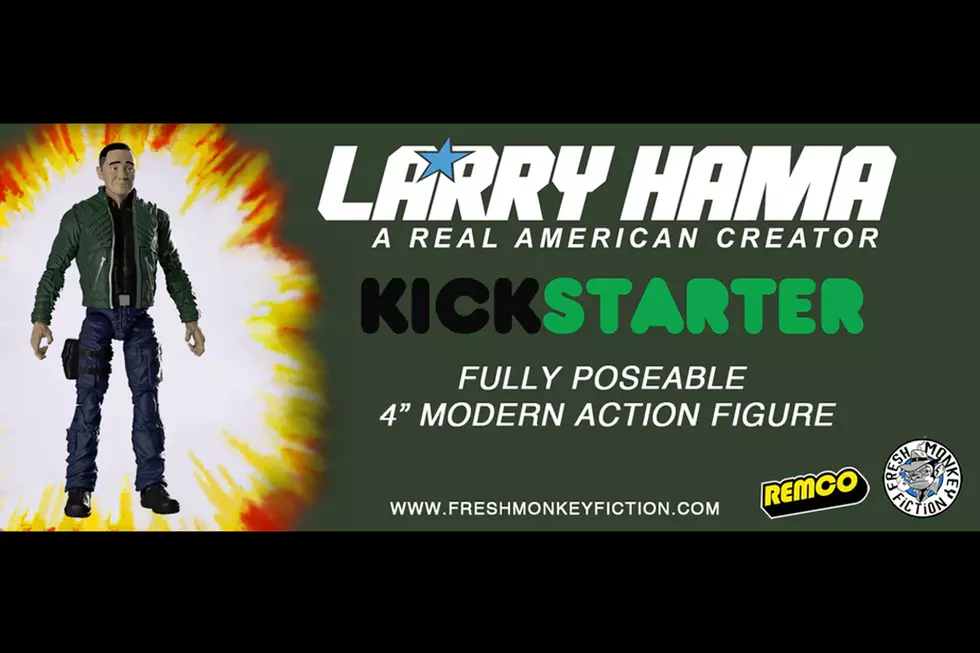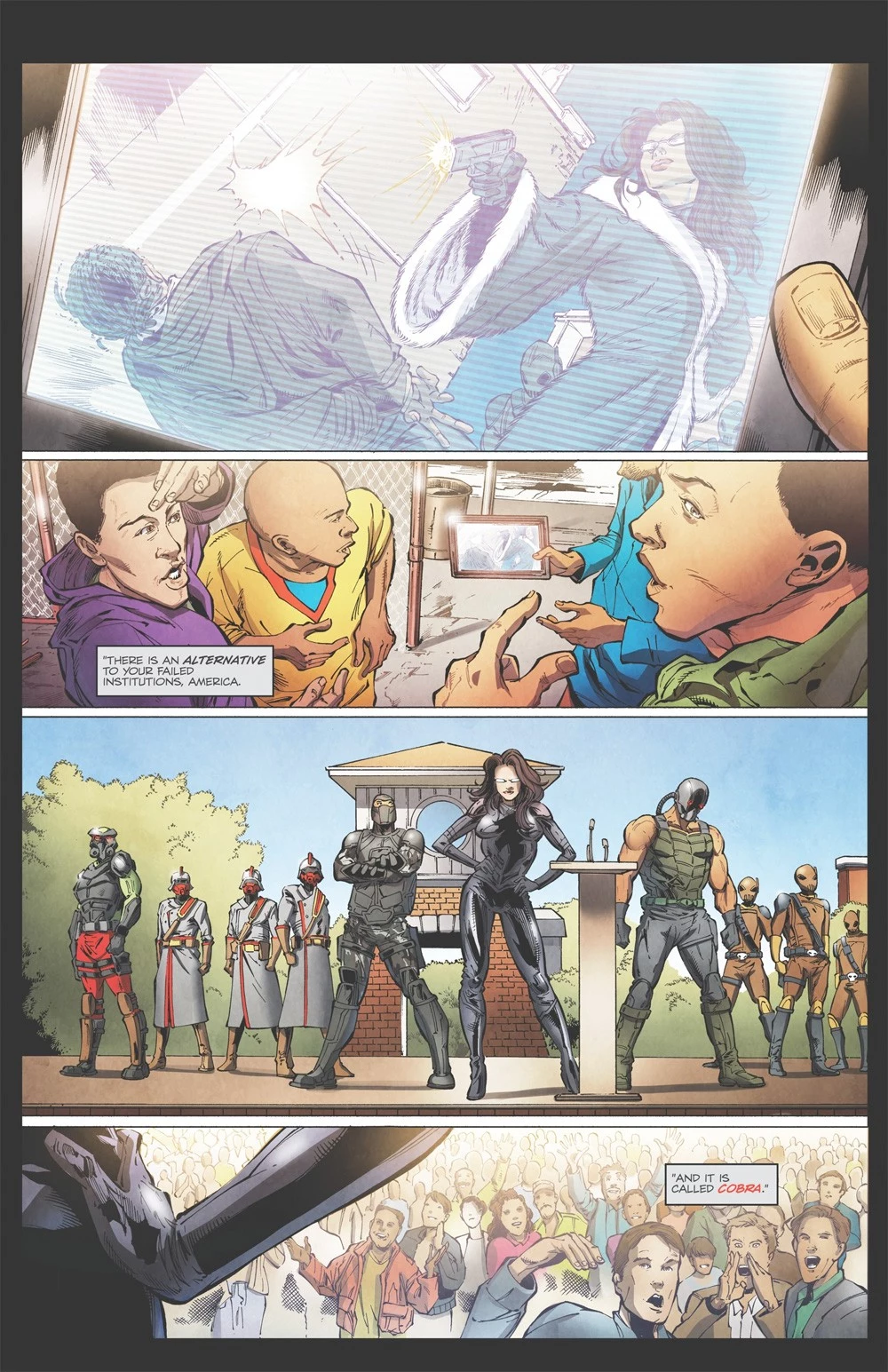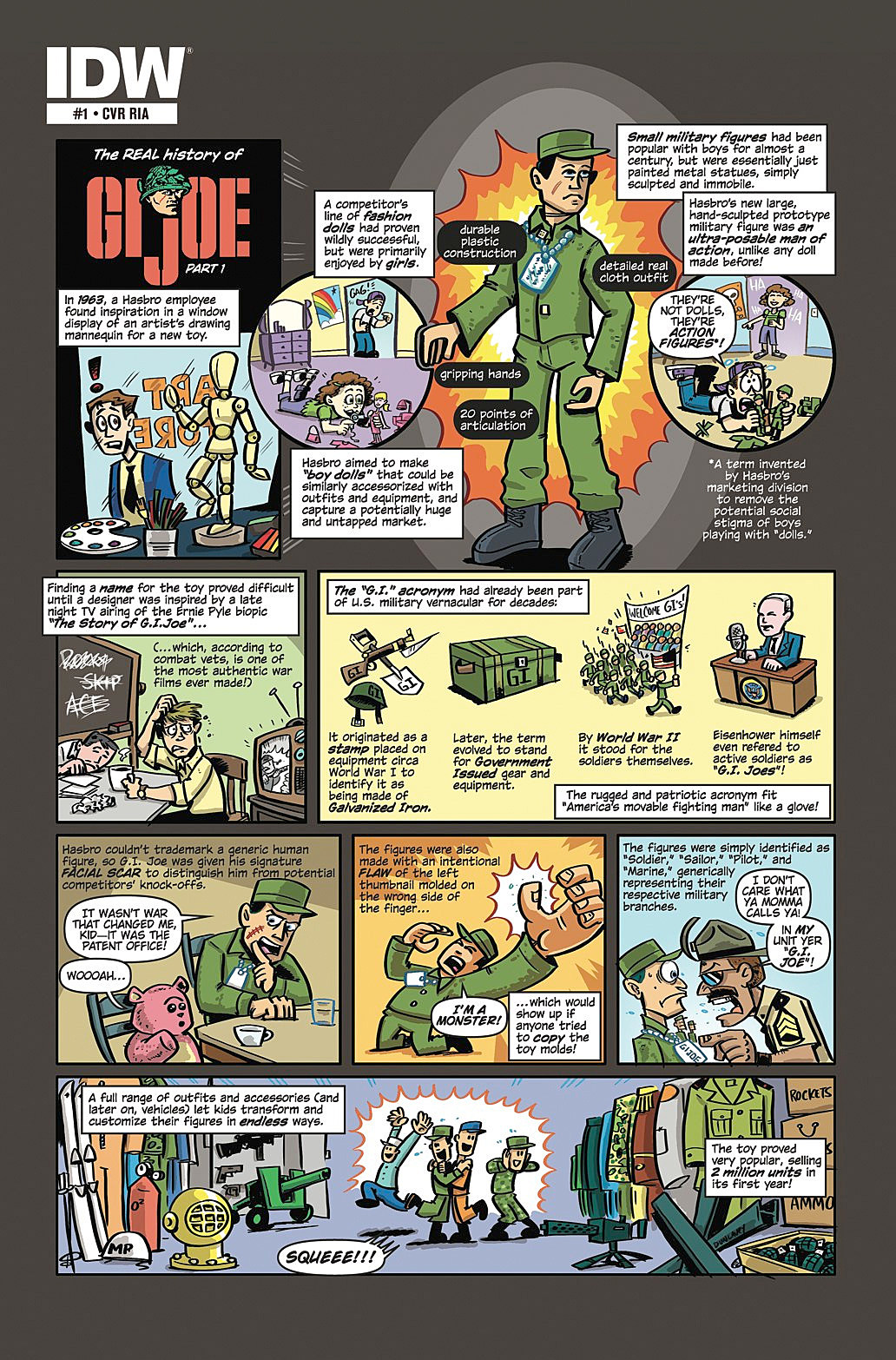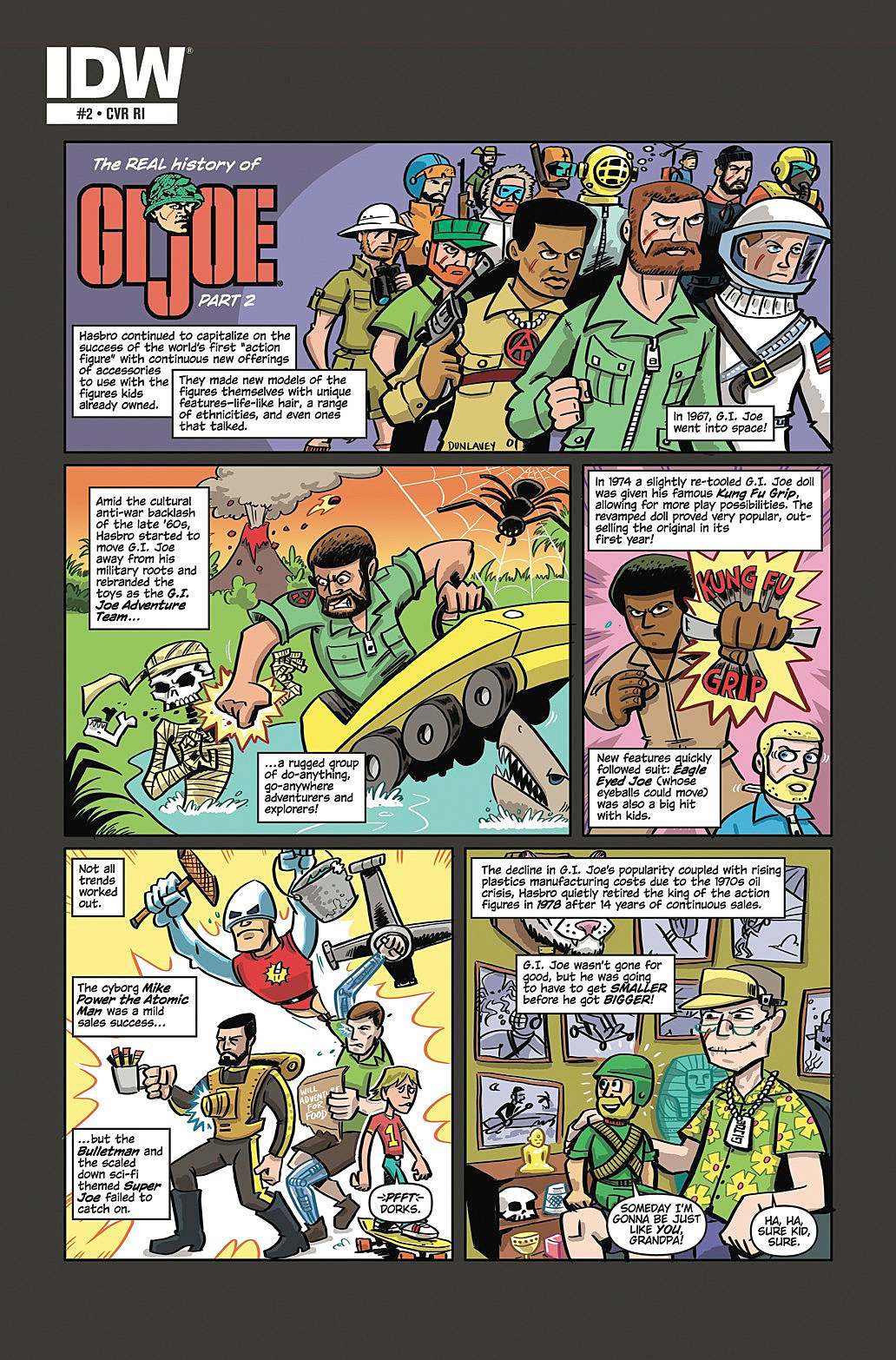![Talking ‘G.I. Joe’ And ‘Archer & Armstrong’ With Fred Van Lente: ‘The Fun Of The Cartoon, With Guys Getting Shot In The Face’ [Interview]](http://townsquare.media/site/622/files/2013/02/joe01.jpg?w=980&q=75)
Talking ‘G.I. Joe’ And ‘Archer & Armstrong’ With Fred Van Lente: ‘The Fun Of The Cartoon, With Guys Getting Shot In The Face’ [Interview]

This week, Fred Van Lente and Steve Kurth launch America's daring, highly trained special missions force into a whole new set of adventures in the pages of G.I. Joe #1. This time, though, the team is operating in the public eye, complete with a new embedded journalist codenamed Hashtag, facing off against a version of Cobra that promises to be both cartoonishly evil and horrifyingly sinister.
We spoke to Van Lente to find out where he's planning to take the Joes, how he's planning to incorporate the "cartoon ethos" into a war story, as well as how it compares with his current (awesome) work on Archer & Armstrong.ComicsAlliance: I never knew you were a G.I. Joe guy. Are you a fan or did you come to it as an outsider?
Fred Van Lente: I was a fan of the comics. I really like Larry Hama's comics from the '80s. I was just too old to have the Hawk, the first line of toys, but I had a couple of the Adventure Team dolls. That's how old I am. I just totally dated myself, in that I had the pre-Real American Hero GI Joe characters. So they're major characters in the new series. Partly because I like having a legacy, and partly just for nostalgia.
CA: They get a mention early on in the first issue, with the Adventure Team being the forerunner of this famous, very public superhero style military team. I think that's a really fun idea, and I wondered why you wanted to take that approach, rather than having the GI Joe team working as a secret organization.
FVL: The outing actually happened in Chuck Dixon's run, which preceded mine. When John Barber at IDW called me up and asked me to do the book, they actually described it as wanting more of a superhero take. I think they meant it as more of a soap opera-type book, but when I hear superheroes, I immediately go "They've got a headquarters, they're media figures." It's the Marvel stance of it, and I thought it was a different way to take the series.
Military services have to deal with public relations and has to deal with hearts-and-minds issues and budgeting, they deal with the media and embedded journalists. It's exciting to introduce some of that stuff, and putting it in there made it, for me, a much more complex and rich environment. Cobra is obviously still the main adversary, but now they have all these other problems as well.
CA: Getting to the idea of Cobra, because you know that's what I wanted to talk about...
FVL: They don't really appear in the first issue. Well, they're mentioned.
CA: Cobra has always had this goofy fun aspect, especially in the cartoon, which is the piece of GI Joe that I love the most.
FVL: I forgot to mention the cartoon. As much as I like Larry's comics, a lot of what I remember about GI Joe, and a lot of what's in this book, is from the cartoon. It's trying to take the ethos of the cartoon and strain it into a more modern comic book.
CA: Even in the comics, there's an interesting silliness. They're a terrorist organization trying to take over the world and they'll actively try to kill the Joes, but Cobra Commander will kick a puppy. That's how he comes back to the book.
 FVL: Yeah.
FVL: Yeah.
CA: How do you find that balance between Cobra being influenced by the cartoon, and still having that fun to them, but still have them taken seriously as a terrorist threat?
FVL: My ethos is, particularly when it relates to G.I. Joe, is that this is a brand originally intended for kids. If you cannot have fun doing a comic book about a children's property, I don't know how to help you. Your problem is not with me. Your problem is with something else out there.
Obviously, Christos Gage and Mike Costa did a great job with their Cobra series of making a lot of those crazier characters creepy and frightening, and you're going to be seeing a lot more of that. Most of the major Cobra characters show up in this book. Baroness is kind of the focus, because I've had a crush on her forever, but yeah. They're a terrorist organization that wants to control the world, and they're going to be very ambitious and start with America, as opposed to ending with it. Their plan in this first arc is fairly nefarious, and it's slowly rolled out but it involves murder and torture, and the threat of murder and torture.
CA: How does the cartoon change your focus in the comic? I noticed that there's kind of a pot-shot at the cartoon, in the scene where Duke talks about how he had to put together a team that was ethnically diverse enough to appeal to the market.
FVL: That wasn't necessarily a pot-shot at the cartoon, but yeah. Shipwreck complains about the outfit, and there's some fun to be had there. A lot of what I'm driven by is taking the elements that clearly show that this is a fun property and frontloading that stuff, rather than trying to paper it over. Not necessarily for the nostalgia factor, but this sort of goes into Archer & Armstrong a little bit too. (Penciller) Emanuela Lupacchino got to a part of the most recent script (#8) where something really terrible happens, and she tweeted me "You must've been in a really bad mood when you wrote these pages."
But I wasn't. That's just kind of how I see the world -- a combination of comedy and horror. With G.I. Joe, the old saw that a soldier's life is boredom punctuated by extreme moments of battle is going to be expressed in our book by the fun of the cartoon contrasted with guys in life threatening situations. You want a guy with a metal face and ninjas, but also immediate, terrifying battle consequences.
It's a combination of the more fun, out there traits of the cartoon with a real, gritty war book. My favorite war book is still Harvey Kurtzman's Two-Fisted Tales, because it shows the desperation and the mud and the violence. This is going to be a very gritty book.
CA: But it'll also be funny.
FVL: Yeah. I wanted to expand it from the sort of special ops milieu, which is a fine genre, but the G.I. Joe team has tanks. There's a reason the Navy SEALs don't have an armored division. There's nothing stealthy about jets and all the other toys, and I wanted to be able to use the toys and tell a wide range of military stories.
CA: What can you tell me about the first story arc? The first issue ends on a very ominous and realistically horrifying note, it just happens to involve Duke and the Baroness. It's a good way to set up the tone, but where does it go from there?
FVL: It's intense. I wanted to do Black Hawk Down, in America, with the G.I. Joe team, and relate it more directly to stuff we've seen in the news and stuff the military has to deal with every day. A lot of the Cobra characters are coming back, some that have never been seen before in the IDW universe. We're going to get a complete origin of Duke, and we're going to see what Cobra's plan is to take over America. They're going to try to be seen as liberators, not conquerors, and there's going to be a significant portion of the United States that thinks American institutions have failed, so they're going to turn to Cobra. They're going to turn to the guy with the metal face.
The town in the first arc, Warrenton, is based on Camden, New Jersey, which is sort of a famously failed city, unfortunately. A lot of this arc was researched using Joe Sacco's new book, Days of Destruction, Days of Revolt, where he goes to impoverished parts of America and reports form there. You're going to get Quick Kick attacking people, and you're also going to get some political stuff, "ripped from the headlines" stuff.
To me, there's something dishonest about doing a war book that doesn't involve politics in some way, and dealing with these issues. I didn't want to do a book that was here's the mission, they go execute the mission, they come back. I wanted to acknowledge the outside world, in the context of guys who can mentally control crocodiles.

CA: So you're confirming that Destro shows up.
FVL: Yes.
CA: The team that you have is very much a classic GI Joe team. Duke and Roadblock are kind of the guys you have to have, but why did you pick those characters? What was it about them that you wanted to work with?
FVL: Some of it's process of elimination. They were going to kill off Snake Eyes, so there's no Snake Eyes. I wasn't able to use Scarlett, because Scarlett has her own book. I wasn't able to use Flint and Lady Jaye, because they have their own book. Duke was the one they said they wanted me to use, and I wanted to use Colton because I'd heard Bruce Willis was playing him in the movie, so I thought that was interesting, and I wanted to bring in the Adventure Team stuff.
Jamal Igle, who did the wraparound cover, is one of my best friends and a huge G.I. Joe fanatic. We were in Mexico City, and we were the only two people that we know who spoke English and I'd just gotten the assignment, so he ended up recommending a lot of those characters, like Tunnel Rat and Quick Kick. Quick Kick is a good replacement for Snake Eyes, obviously, and Tunnel Rat was partially inspired by Larry Hama, so I wanted to use him for that reason.
Doc, I just wanted her because I had an interesting story for her to do. Cover Girl was the only girl available. [Laughs] At least of the major ones. I had to use her: Supermodel becomes super-soldier! You can't not use that. The Cover Girl origin issue is coming up shortly, and I'm very excited.
CA: Let's talk a little bit about Hashtag.
FVL: Sure.

CA: We had a little fun with Hashtag here at ComicsAlliance.
FVL: I saw! I loved it.
CA: I do actually think Hashtag is a good idea. I think she's fun, and I love the name. How did she come about? Was it just a product of doing the public GI Joe team?
FVL: Yeah. It was an embedded journalism concept. In the first issue, the idea is that the brass chooses for the G.I. Joe team what they think is going to be a relatively simple mission, so they want to make as big a public splash as possible, so they send her with them. Originally, she was going to be a civilian, but Hasbro wanted me to make her a part of the military. I didn't want her to be 100% military for reasons that will quickly become obvious, so I had her be ROTC.
And, you know, she's another obstacle other than Cobra. I'm not trying to put Cobra in the background, but Cobra's got their own book. While the G.I. Joe team is fighting Cobra, I wanted to set up some other problems that weren't just "Cobra's shooting at us." Hashtag has a really interesting arc. I knew the minute I came up with her, she'd be the most controversial element of the new series, and she'll only get more controversial as the series continues, but she has a very nice ending.
CA: So you have a planned ending for Hashtag already? Is she not long for this world?
FVL She has an arc. How's that? Her arc has a beginning, a middle, and an end.
CA: Oh no.
FVL: It's war, baby!
CA: How many names did you go through?
FVL: Just one. It's funny, you'll appreciate this: I was seriously considering just making her [former ComicsAlliance Editor-in-Chief] Laura Hudson. But then I was talking to someone who mentioned that there had never been any G.I. Joe team members of Indian descent. [Marvel Director of Communications] Arune Singh really helped me with suggesting characters, so I named her after him. And I did that not realizing that in the IDW Universe, Dr. Mindbender's last name is "Singh," so now everyone's going to think that they're related. But they're not. There is no connection, I promise.
CA: Obviously, GI Joe is essentially a book about soldiers fighting against a big crazy organization of bad guys. Archer & Armstrong is a book about guys fighting multiple giant crazy organizations bent on world domination and destruction. To be honest, knowing that you were coming in on GI Joe made me read Archer & Armstrong differently.
FVL: [Laughs] That's interesting.
CA: You have the two guys from the One Percent walking around, and I'm like "Oh, that's totally Tomax and Xamot."
FVL: One was a bear and one was a bull! They're not twins, they're different species!
CA: They're wearing masks! You can't tell. I read them with Tomax and Xamot's voice from the cartoon.
FVL: There's ninjas in Archer & Armstrong. They're nuns.
 CA: We talked about how much I like the GI Joe cartoon and how it's an influence on your book, and there are those big, weird cartoon bad guy organizations in Archer & Armstrong that I love.
CA: We talked about how much I like the GI Joe cartoon and how it's an influence on your book, and there are those big, weird cartoon bad guy organizations in Archer & Armstrong that I love.
FVL: Half the fun is coming up with all the crazy organizations. The hardest one was the one we're doing right now, the Null. The Null started out as basically the Sinestro Corps, they're evil Geomancers. I had called them the Silence, and then I was at the Valiant summit and Fred Pierce pointed out that there's a very famous bunch of Doctor Who villains called the Silence, which I was not aware of. I was scrambling for a new name, and I happened to be reading a very good book called Why Does The World Exist?, by a guy named Jim Holt.
It's about him going around and interviewing various artists and cosmologists and physicists and philosophers and religious thinkers, trying to answer the question "Why is there something instead of nothing?" One of the most compelling answers to that question, from a cosmological standpoint, is that the question's wrong. You're assuming "nothing" is an option. So I became very interested in this idea of being obsessed with nothingness, and the name "The Null" was coined by Jody LeHeup, one of our great editors. It dovetailed neatly into what I was reading about, logical arguments for the existence or nonexistence of God or the Universe.
CA: That's an interesting set of bad guys for a bunch of superheroes to fight.
FVL: I resist the idea of Archer & Armstrong being superheroes, since they don't have secret identities or costumes, although they don't ever seem to change their clothes. But that's different. The Simpsons don't change their clothes, but they're not superheroes.
CA: Yeah, but one of them is a super-trained martial artist and the other is super-strong and immortal. And there's a third one that can talk to the world.
FVL: Well, they're super, but that doesn't make them superheroes.
CA: They're also fighting against bad guys.
FVL: Aren't you and I fighting against bad guys every day of our lives?
CA: My daily life does not tend to involve hand-to-hand combat.
FVL: I avoid hand-to-hand combat as if it was... hand-to-hand combat, actually.
CA: So you don't consider Archer & Armstrong to be a superhero book?
FVL: I don't. It's not something that I get hung up on, I don't care if people call it a superhero book. I don't, but part of it is that I got burnt out doing superheroes at Marvel, so recently I've managed to carve out a niche where I wasn't doing superheroes, at least not in comics. But yes, they're trying to stop people from blowing up the world. By that standard, James Bond is a superhero, and there's certainly a perfectly reasonable argument to be made that he is in fact a superhero. But the nomenclature is not something I'm going to get hung up on.

CA: It's funny that you talked about G.I. Joe, which is ostensibly a "military action" book, is something that you're approaching as a superhero comic, when Archer & Armstrong is not. I'm curious to know what the line is. What makes Archer & Armstrong different from Incredible Hercules?
FVL: They're very similar. They certainly approached me because of Incredible Hercules. They actually are very similar, because Hercules was very much about religion, faith, gods and mythology, and whenever you do anything that involves conspiracies, you eventually go down this rabbit hole where you try to find an explanation for everything. It's essentially what conspiracy myth is.
I like to call conspiracy theories the mythology of the impotent. It's powerless people who believe that the system's been rigged in general or rigged against them specifically, or both, trying to make sense of larger events that happen in the world.
When Steve Jobs died, I was taking a cab across Brooklyn, and the cab driver was listening to the news on the radio. As I was paying him, he goes out of nowhere "Do you think he's really dead? I think he's on an island somewhere. He's got an island and he just dropped out." It's almost like someone as powerful as Steve Jobs couldn't just die, like any regular mortal. A guy like him must have figured out some other arrangement. There's gotta be some hidden mystery, some angle you can work. Sightings of Elvis and aliens, it's all God and afterlife stuff because you want to believe there's meaning to your life that is not imposed by you, that comes from somewhere else. Conspiracy myth ends up being very much the sinister side of religion.
I think we're going to get more into that in Archer & Armstrong, so I guess I'm answering your question by saying that there's not a lot of difference. [Laughs] I'm doing some similar beats and I have to stop that. It's not a rerun of Incredible Hercules because the subject matter's so different, but they are very similar books because they both deal with these issues of myth.
CA: Is that where the villains come from? They're conspiracy theories extrapolated to adventure story villains.
FVL: Yes.
CA: You do a big Assassin's Creed/Da Vinci Code bit in the first arc, the One Percent are pretty obvious. Is that the driving force, that you just want to do big fun conspiracy theories as bad guys who can get punched? And I mean that in the best way possible.
FVL: [Laughs] No, you're right! It's accurate! A lot of it is about Ama -- I almost called him Amadeus. Oops. [Laughs] It's about Archer, this guy who was raised in this really cloistered environment. The comparison I always like to use is that I was very religious as a teenager. I was definitely in a super liberal congregation, I was part of the United Church of Christ, which I believe is what Reverend Jeremiah Wright's congregation was. I got laid for the first time there, I got my first girlfriend through the church youth group, but once I went to college and got out of that environment, I lost the faith pretty quickly and ended up floundering for a while about what my purpose was and what my spirituality was going to be. You're going to see that with Archer. It's a much more extreme, hyper-dramatic thing than I went through, but the structure of the book is going to become more apparent as Archer's quest to find himself and Armstrong helping and impeding him.
Armstrong says that self-improvement is great, but he stopped improving himself around 315 AD, because he realized he was about as good as he was going to get, you know? The next arc has the return of the Dominion, the bad guys from the first arc, but there's going to be mysterious disappearances, dinosaurs, alien Greys, Ambrose Bierce and the lost colony of Roanoke, and the bad guys are going to be back after the Boon, which was the McGuffin of the first arc.
More From ComicsAlliance
![The Silver Age Is In Full Swing In ‘Comic Book History Of Comics’ #5 [Preview]](http://townsquare.media/site/622/files/2017/03/CBH05-featured.jpg?w=980&q=75)

![The Dreadnoks Are Back At It Again In ‘GI Joe’ #3 [Preview]](http://townsquare.media/site/622/files/2017/03/GIJoe00.jpg?w=980&q=75)

![Don’t Lose Your Head Over ‘Immortal Brothers: Tale Of The Green Knight’ [Preview]](http://townsquare.media/site/622/files/2017/03/GreenKnight01.jpg?w=980&q=75)
![The Unvarnished, Unpretty, Unchivalrous Truth: Fred Van Lente On ‘Immortal Brothers: The Tale Of The Green Knight’ [Interview]](http://townsquare.media/site/622/files/2017/01/ImmortalBros.jpg?w=980&q=75)









